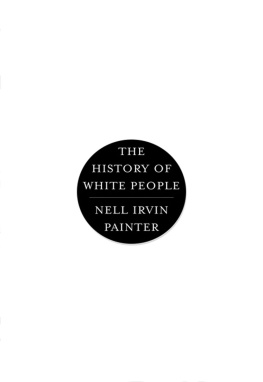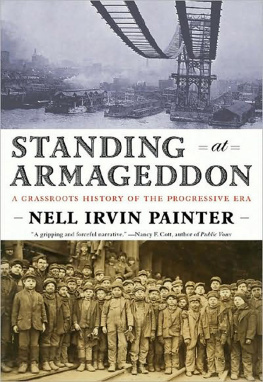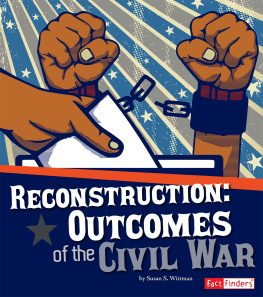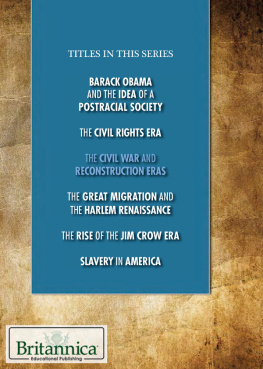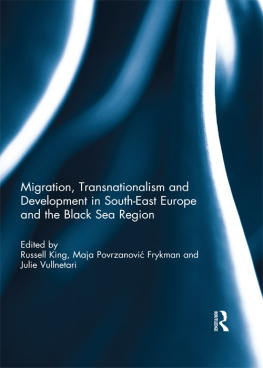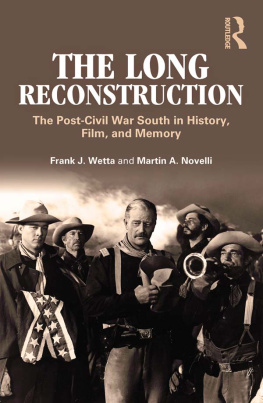Painter - Exodusters: Black migration to Kansas after Reconstruction
Here you can read online Painter - Exodusters: Black migration to Kansas after Reconstruction full text of the book (entire story) in english for free. Download pdf and epub, get meaning, cover and reviews about this ebook. City: New York;Kansas, year: 1992, publisher: W. W. Norton & Company, genre: Politics. Description of the work, (preface) as well as reviews are available. Best literature library LitArk.com created for fans of good reading and offers a wide selection of genres:
Romance novel
Science fiction
Adventure
Detective
Science
History
Home and family
Prose
Art
Politics
Computer
Non-fiction
Religion
Business
Children
Humor
Choose a favorite category and find really read worthwhile books. Enjoy immersion in the world of imagination, feel the emotions of the characters or learn something new for yourself, make an fascinating discovery.
- Book:Exodusters: Black migration to Kansas after Reconstruction
- Author:
- Publisher:W. W. Norton & Company
- Genre:
- Year:1992
- City:New York;Kansas
- Rating:5 / 5
- Favourites:Add to favourites
- Your mark:
- 100
- 1
- 2
- 3
- 4
- 5
Exodusters: Black migration to Kansas after Reconstruction: summary, description and annotation
We offer to read an annotation, description, summary or preface (depends on what the author of the book "Exodusters: Black migration to Kansas after Reconstruction" wrote himself). If you haven't found the necessary information about the book — write in the comments, we will try to find it.
Painter: author's other books
Who wrote Exodusters: Black migration to Kansas after Reconstruction? Find out the surname, the name of the author of the book and a list of all author's works by series.
Exodusters: Black migration to Kansas after Reconstruction — read online for free the complete book (whole text) full work
Below is the text of the book, divided by pages. System saving the place of the last page read, allows you to conveniently read the book "Exodusters: Black migration to Kansas after Reconstruction" online for free, without having to search again every time where you left off. Put a bookmark, and you can go to the page where you finished reading at any time.
Font size:
Interval:
Bookmark:

Copyright 1976, 1986 by Nell Irvin Painter
All rights reserved
Originally published by Alfred A. Knopf, Inc., in 1977.
Published as a Norton paperback 1992
by arrangement with the author and Alfred A. Knopf, Inc.
The Library of Congress has cataloged the printed edition as follows:
Painter, Nell Irvin.
Exodusters: Black migration to Kansas after
Reconstruction.
Bibliography: p.
Includes index.
1. Afro-AmericansKansasHistory. 2. Kansas
History. 3. Afro-AmericansHistory18771964.
I. Title.
E185.93.K16P34 1986 978.100496073 86-5500
ISBN 0-393-00951-3
ISBN 978-0-393-00951-4
ISBN 978-0-393-35251-1 (e-book)
W. W. Norton & Company, Inc.
500 Fifth Avenue, New York, N.Y. 10110
www.wwnorton.com
W. W. Norton & Company Ltd.
Castle House, 75/76 Wells Street, London WIT 3QT
Exodusters, which was first published in 1976, began as a dissertation entitled The Origins of the Exodus to Kansas of 1879, and that is exactly what this book is aboutthe experiences of freedpeople in Mississippi, Louisiana, and Tennessee during Reconstruction, to whose ending the Exodus was a response. The Exodusters who left the lower Mississippi Valley in a millenarian movement, seeking new homes in the freedom of Kansas, were ordinary, uneducated former slaves, whom one of them called a class of hard laboring people. In this story, their class and their immediate history as slaves are practically as important as their race (although not in their eyes or in the eyes of their oppressors). The freedpeoples struggle was against what they saw as actual or effective reenslavement. And in fact, the forces ruling their states after Reconstruction did set about constructing a set of laws that would make and keep nearly all of them a powerless, immobilized, landless agricultural work force. The impulse to flee came from the conditions that freedpeople lived in and that they anticipated for the future. But Black men living in cities in the North and South, who did not suffer the pressures that were so disturbing in the rural areas, did not reach the same conclusions about the need to leave the South immediately. Many of the more privileged Blacks, men of more wealth, education, and autonomy, opposed the Exodus when it occurred two years after the compromise that we now take as the formal end of Reconstruction.
Unlike many other histories of Reconstruction, this book does not focus on Washington or the state capitals of the South. My central figures are not officeholders or men able to influence policy directly. (I say men because women, while they participated in the Exodus, were not voters during Reconstruction and do not appear as actors or speakers in the sources.) The main characters here are men like Henry Adams, a former slave, former United States soldier, faith healer, and laborer. In focusing primarily on what Reconstruction meant in the counties and parishes of the lower Mississippi Valley, this book begins to speak of nationally known figures only toward the end, in a discussion of what prominent people said after the Exodus had attracted attention throughout the country and the famous had to formulate positions in its regard. First and foremost, this is a study of the grass roots that seeks to delve into and explain the meaning of economic and political emancipation for the masses of Southern Blacks after the Civil War.
The Exodus is the pivotal event in this book, but I have used it in order to discover what ordinary Southern Black people were doing and thinking in freedom and how they tried to adjust to the failure of citizenship when Reconstruction ended. But while this book is about what happened at the grass roots, perhaps some guidance about what was going on throughout the South and in Washington will put the origins of the Exodus into broader perspective.
Although the Civil War had begun as a war for reunion, by 1863 it had become a war against slavery and against the Confederate elite that had taken eleven Southern states out of the union. Planters had dominated the secession legislatures, and planters dominated the Confederacy, so that the Civil War in the South entailed a clear class conflict. On the one hand, non-slaveholding whites, particularly whites in the upcountry districts that were far poorer than the plantation Black belts, tended to oppose secession and to undermine the Confederate cause during the war by deserting. But for my purpose here, the conflict between slaves, the most oppressed of working people, and their masters, the most powerful of employers, was more important. Where planters overwhelmingly supported the Confederacy, slaves were the Souths truest Unionists. Whenever the United States Army came within striking distance, slaves flocked to its ranks, seeking freedom. This political conflict between masters and slaves, so often identified as a racial conflict, was, at bottom, a conflict between workers and employers, between poor people and wealthy people, in which race functioned as the idiom for discussion of class. Unless the terms of the discussion were modifiedpoor white, educated Blackthe word black meant poor and white meant rich.
Freedom disturbed the hierarchical arrangements between worker and employer and between master and slave in ways that varied tremendously from person to person and between masters and slaves, as Leon Litwack, in Been in the Storm So Long (1979), and James L. Roark, in Masters without Slaves (1977), have shown. Masters believed that their former slaves, whom they had difficulty envisioning as other than slaves, would perish without the guidance and discipline of slavery to protect them from the consequences of their ignorance. Masters were also convinced that Black people would not work without compulsion. In this conclusion, they defined work in a peculiar way that was not the same as the freedpeoples.
Freedpeople welcomed work, but not as planters saw it. Eager to work for themselves, freedpeople were less interested in producing for the cotton market or for any other market. Subsistence farming was their ideal, and they were not willing to work in gangs for their former masters. For planters, only closely supervised gang labor was work, which freedpeople tended to avoid. One of the first systemic tensions between former masters and former slaves in the postwar South was defining work and ultimately forcing former slaves to accept most of the planters definition of it. The conflict involved access to land and terms of tenant farming and sharecropping. But this was not the only case of conflicting responses to freedom.
As in most employer-employee relations, particularly in agricultural settings, slavery had included an enormous increment of deference. Slaves were expected to be humble before masters, and masters punished any evidence of autonomy or independence on the slaves part as impudence. Examples of impudence stud the record of slavery, but emancipation saw thousands of freedpeople throw off slaverys mask. Abruptly discarding the pose of deference, cooks turned on their heels and refused to serve their masters; serving girls cursed their young mistresses; workers in the fields stopped their labor until their former owners agreed to pay them a wage; drivers on absentee-owned plantations threatened the returning owners at gunpoint; and prophets proclaimed the arrival of the New Jerusalem. In these ways, the first acts of emancipation were psychological and face-to-face. They did not go unchallenged.
The response was a wave of anti-Black violence that merged into the anarchy that followed the end of the war. Marauding Confederate soldiers, called disserters by Southerners, stole pigs, burned barns, ran off horses, and shot Blacks in the roads. Sources make it difficult to draw any conclusions about the race of these perpetrators of the arson and thievery that followed the surrender. During this turbulent time, a lack of law enforcement, anger at the Confederate loss (blamed on Blacks), hunger, and wantall combined to produce a tide of disorder whose salient was anti-Black terrorism.
Next pageFont size:
Interval:
Bookmark:
Similar books «Exodusters: Black migration to Kansas after Reconstruction»
Look at similar books to Exodusters: Black migration to Kansas after Reconstruction. We have selected literature similar in name and meaning in the hope of providing readers with more options to find new, interesting, not yet read works.
Discussion, reviews of the book Exodusters: Black migration to Kansas after Reconstruction and just readers' own opinions. Leave your comments, write what you think about the work, its meaning or the main characters. Specify what exactly you liked and what you didn't like, and why you think so.


